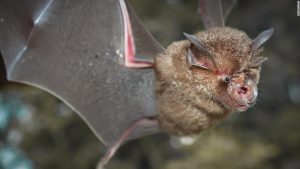Silent, elusive, and active while the world sleeps, bats have been victims of myths and legends for centuries. However, far from their sinister reputation, these night guardians are true biological wonders. With over 1,400 species distributed across almost the entire planet—except for the coldest regions—bats stand out for their incredible adaptability.
They are the only mammals capable of active flight, thanks to their limbs transformed into wings. Additionally, they master a fascinating ability: echolocation, by which they emit ultrasonic sounds and capture the echoes to navigate and hunt in complete darkness.
Not all bats feed the same way. Some are insectivorous, others frugivorous, nectarivorous, or even fishers. This diversity of diets makes them essential allies for natural balance: they control pests, pollinate plants, and disperse seeds, playing essential roles in numerous ecosystems.

Iberian Bats: Invisible Neighbors
In Spain, more than 30 different species inhabit. They live in caves, forests, rural areas, and even in cities, where they take refuge in old buildings, crevices, and rooftops. Many of them are protected by law due to their vulnerability and ecological importance.
One of the most common is the pipistrelle bat, the smallest in Europe, which usually forms urban colonies and feeds on mosquitoes and moths, being a very effective natural insecticide.
Another remarkable species is the greater horseshoe bat, larger in size with a peculiar nasal structure. It is mainly found in the northern Iberian Peninsula and emits ultrasonic sounds from its nose to hunt. It lives in caves, forests, and abandoned buildings.
World Bats: Borderless Marvels
Outside of Europe, there are bats that are even more surprising. The flying fox of the Pacific can have a wingspan of up to one and a half meters. The fishing bat in Central America catches fish with its claws, and the vampire bat—which feeds on blood—is just one rarity within the vast chiropteran universe.
Curious Facts from a Hidden World
- Some species can live over 30 years.
- During hibernation, their heart rate drops by up to 90%.
- They are social and care for their offspring in groups.
- A single bat can eat over 3,000 insects in one night.
- They communicate through complex vocalizations, and some even sing.
Far from being a threat, bats are invisible allies in biodiversity conservation. Getting to know them better is the first step to protect them—and to admire one of the most extraordinary groups of mammals on the planet.

Why Are They So Important for the Environment?
Bats are crucial for the ecosystem due to their role as insect pest controllers, pollinators, and seed dispersers. Additionally, they are vital for human health by eliminating mosquitoes that can transmit diseases.
The Role of Bats in the Ecosystem
- Pest control: Insectivorous bats consume large amounts of insects, including agricultural pests and disease vectors like mosquitoes.
- Pollination: Some bat species pollinate plants such as avocados, bananas, tomatoes, and cocoa, contributing to the reproduction of these species.
- Seed dispersal: Frugivorous bats transport seeds of plants, aiding in forest regeneration and plant diversity.
- Human health: By eliminating mosquitoes, bats help prevent diseases transmitted by these insects, such as dengue and chikungunya.
- Food for other animals: Bats also serve as food for other predators, contributing to the balance of food chains.
Source: Beonloop.

